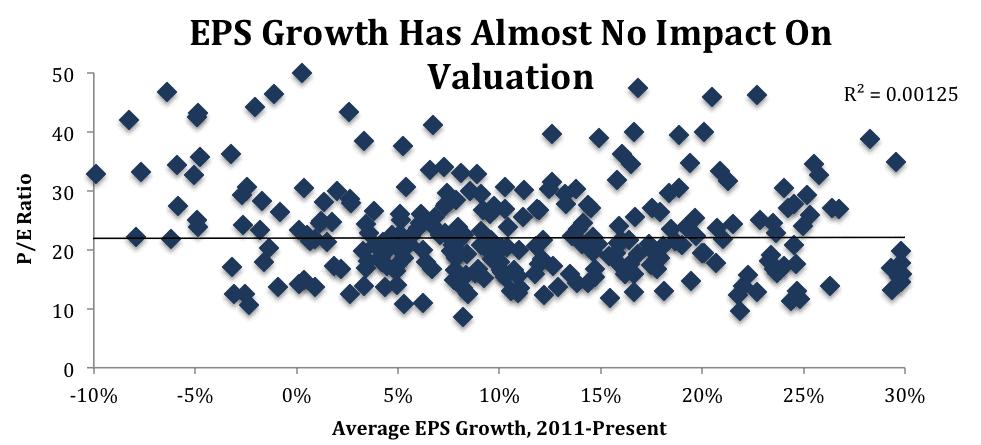Corporate earnings season may be winding down, but the real earnings season—annual 10-K filing season—starts today.
Corporate earnings announcements provide investors with limited and often misleading data. Only by reading all of the financial footnotes, which are only included in annual 10-K reports filed with the SEC, can investors know the true profits of publicly-traded companies.
Successful value investors such as Warren Buffett know that it’s essential to read 10-Ks. It’s the only way to reverse accounting distortions and calculate true return on invested capital (ROIC).
Reported Earnings Per Share Don’t Matter
Historical data shows that reported earnings growth has a relatively limited impact on valuation, both for individual companies and the market as a whole. Figure 1 shows that EPS growth rate has almost no correlation with P/E ratios for stocks in the S&P 500.
Figure 1: Earnings Growth Vs. P/E Ratio For The S&P 500
Sources: New Constructs, LLC and company filings.
Cash is a fact. Earnings are an opinion. Investors who base their investment decisions on accounting earnings put their portfolios at risk. Advisors who make investment recommendations without performing proper due diligence are not fulfilling their fiduciary responsibilities.
Using Machine Learning To Provide Diligence At Scale
ROIC is much better than EPS at explaining changes in valuation. Unfortunately for investors, it is very difficult to calculate accurately. It’s not enough to read financial statements. A rigorous calculation of ROIC must account for items that are buried in hundreds of pages of footnotes.
For a human analyst, performing this level of analysis on just a handful of companies is a daunting task. Applying that level of rigor to thousands of companies is downright impossible. That’s where our technology comes in.
We use machine learning and natural language processing to automate the analysis of corporate filings. Our statistical comparison engine, which has been trained on over 120,000 human-verified filings and grows more sophisticated every day, can filter through SEC filings to recognize and tag important data, automatically building company models.
Of course, human analysts remain a vital part of the process. From mid-February through the end of March, our expert team of analysts will be coming in early and staying late to validate the data and models built by the machine and interpret unusual items that cannot be automatically processed.
This combination of computerized processing power and human expertise allows us to provide investors with the most accurate research from the “real” earnings season.
Diligence Pays
All stock research is ultimately judged on one metric: the performance of picks. Over the past year, our in-depth research has helped deliver excess returns to investors.
Most notably, our Executive Compensation Aligned With ROIC Model Portfolio is up 25% vs. 11% for the S&P 500 since its inception in May of last year. This model portfolio combines our footnotes research with evaluation of executive compensation plans to find profitable, attractively valued companies with incentives for executives to maximize ROIC.
Lear Corp (LEA) has been in the Exec Comp model portfolio since its inception and is up 25% over that time. In addition to its stellar executive compensation plan, we found a couple of items in the footnotes of LEA’s 2015 10-K that revealed the company was more profitable than the income statement suggested.
On page 59, we found a $6.2 million increase to the company’s inventory reserve. Increasing reserves do not affect the actual cash flow of the company, but they do decrease reported profits.
On page 62, we found $5.7 million in asset write-downs hidden in operating earnings. Write-downs are a non-cash, non-recurring charge that do not impact operating cash flow.
LEA has already filed its 10-K for 2016, and it continues to earn our Very Attractive rating. On page 80 of its 2016 10-K, we found a $34.4 million non-cash, non-recurring expense due to a pension settlement charge. LEA grew GAAP EPS by 39% in 2016, but its economic earnings per share managed to grow at a slightly faster rate, a good sign for investors.
Diligence in the footnotes can also protect investors against capital losses.
Acadia Healthcare (ACHC) showed rapid growth in reported earnings per share over the past few years, but our models showed cash flow and ROIC on the decline. We warned investors about this disconnect last July, and the stock is down 20% since that time while the S&P is up 9%.
All the media buzz during “earnings” season tends to push investors into shortsighted trades. We help long-term investors create a durable competitive advantage by reading thousands of 10-Ks so they can invest with the level of diligence they’ve always wanted but could not get before.
This article originally published here on February 21, 2017.
Disclosure: David Trainer and Sam McBride receive no compensation to write about any specific stock, sector, style, or theme.
Follow us on Twitter, Facebook, LinkedIn, and StockTwits for real-time alerts on all our research.
Scottrade clients get a Free Gold Membership ($588/yr value) as well as 50% discounts and up to 20 free trades ($140 value) for signing up to Platinum, Pro, or Unlimited memberships. Login or open your Scottrade account & find us under Quotes & Research/Investor Tools.
